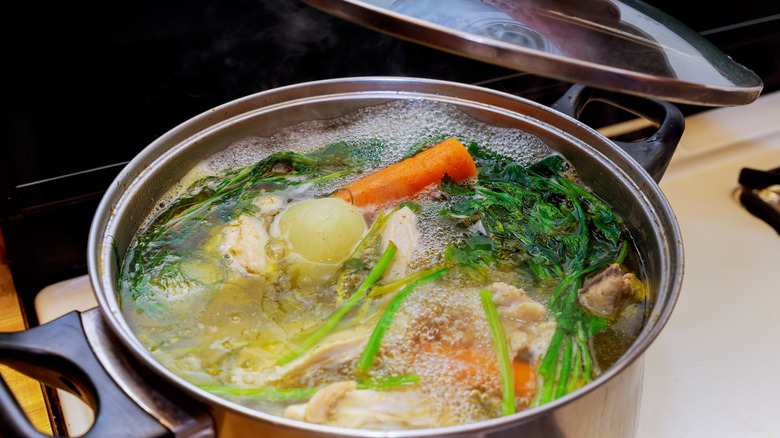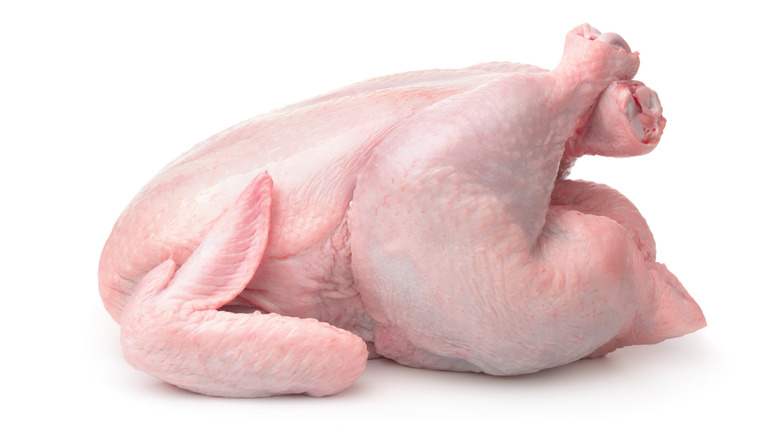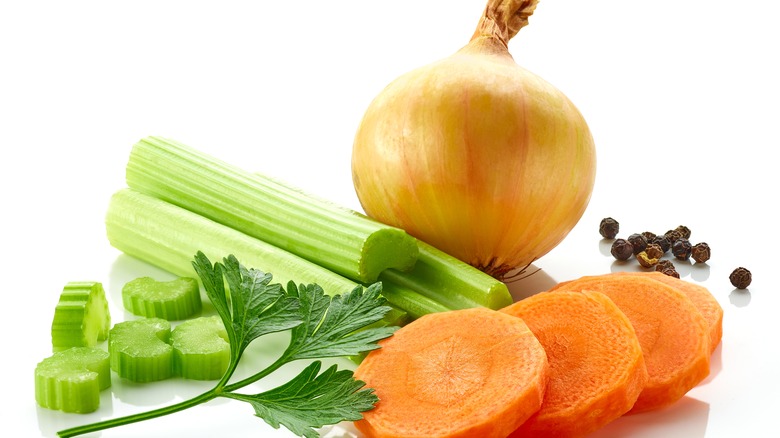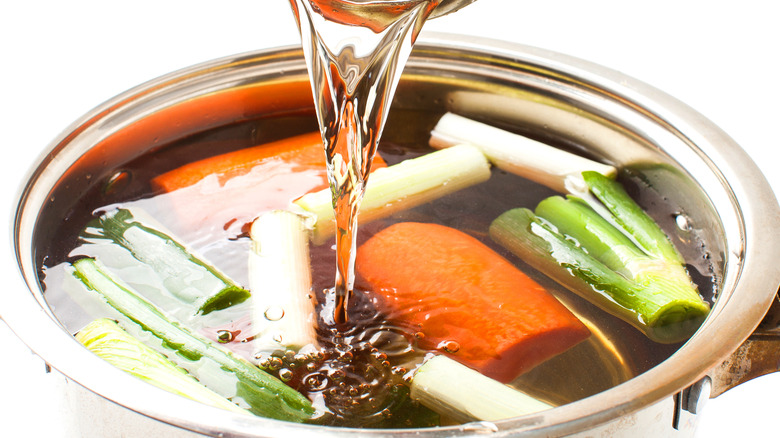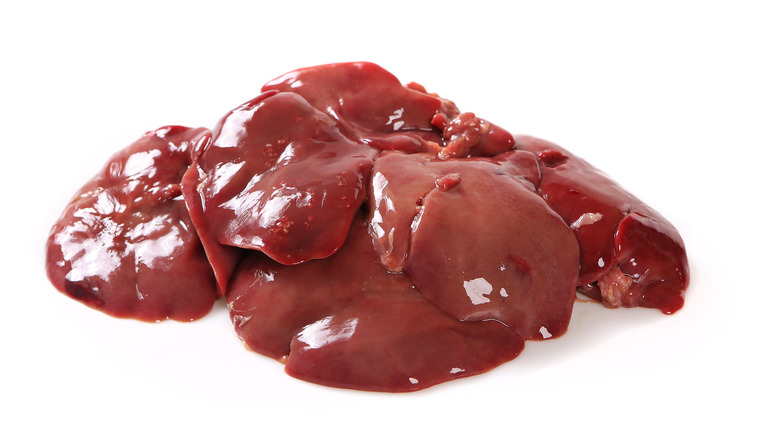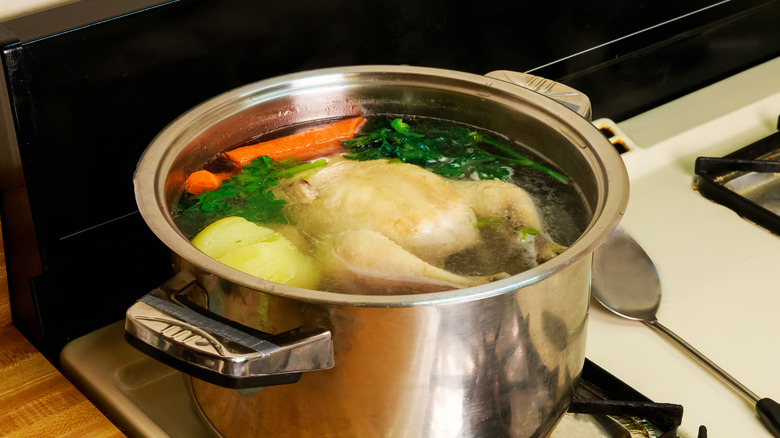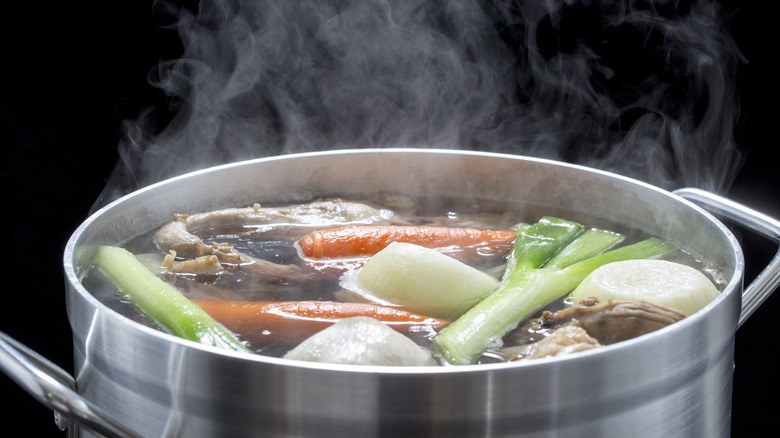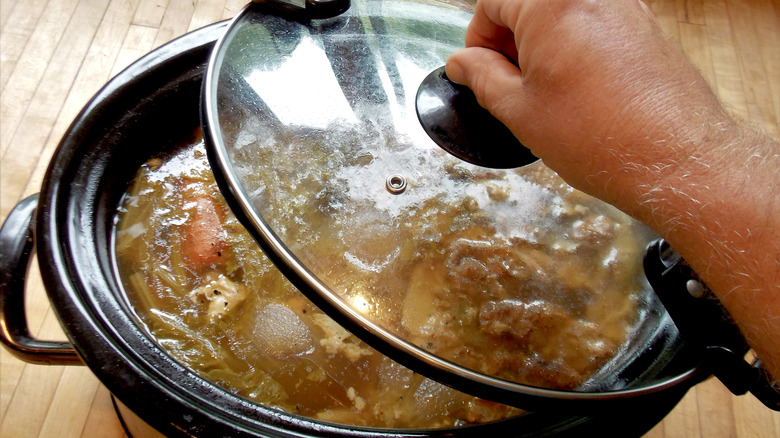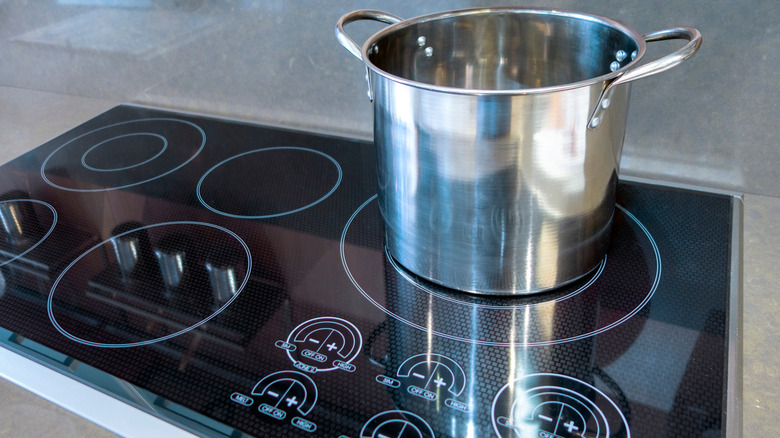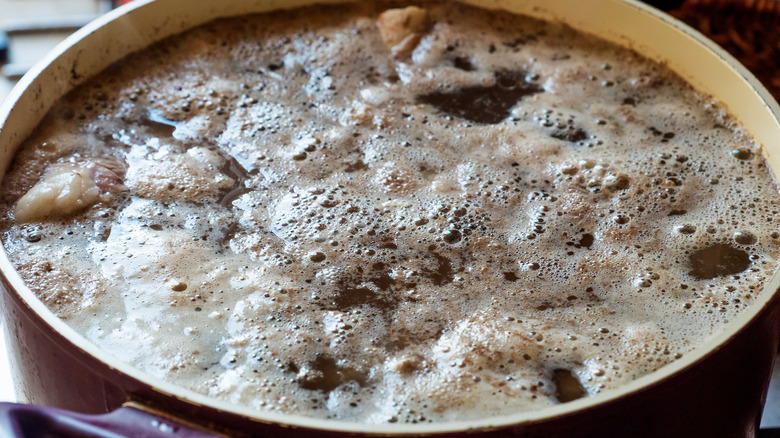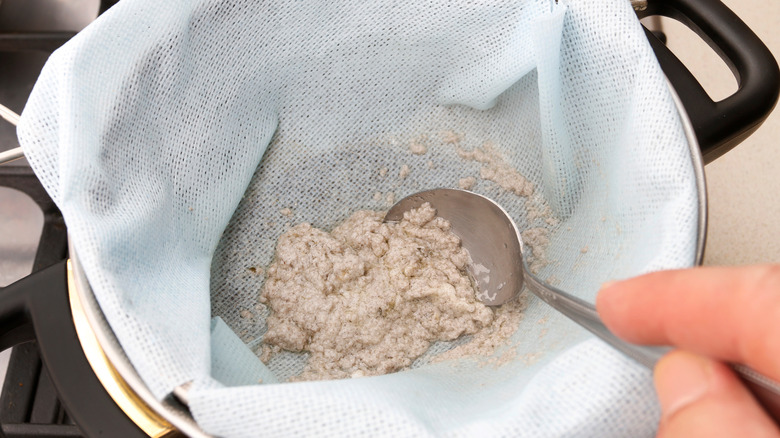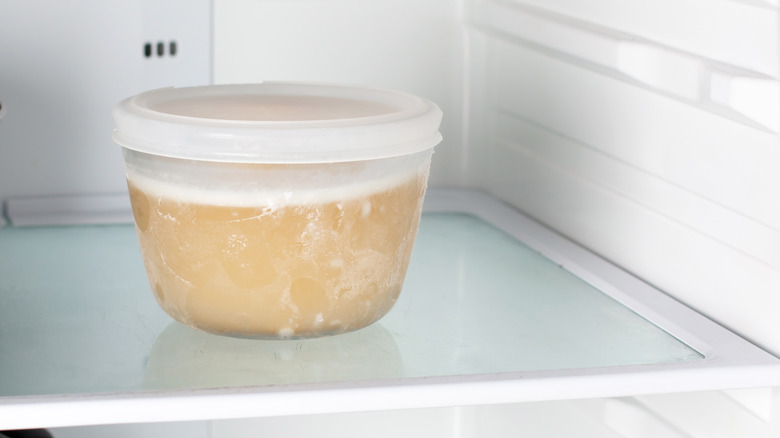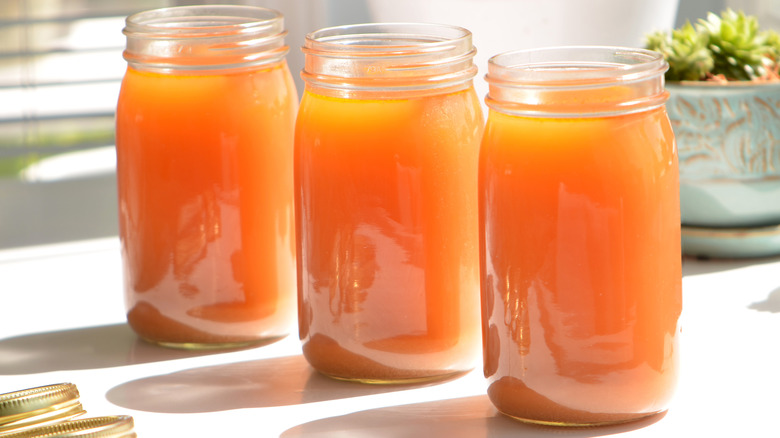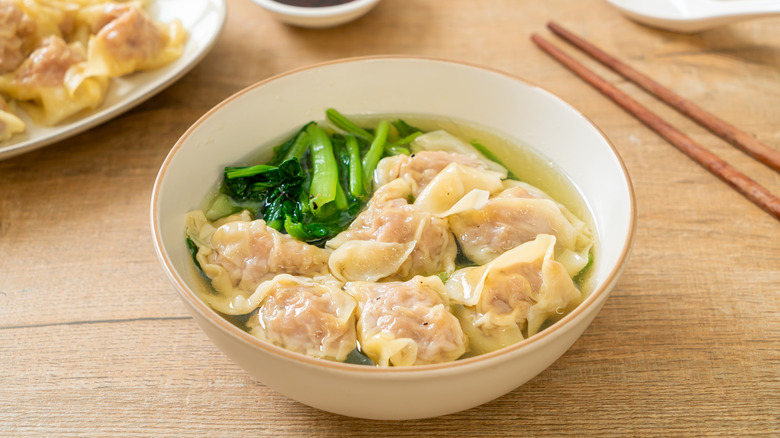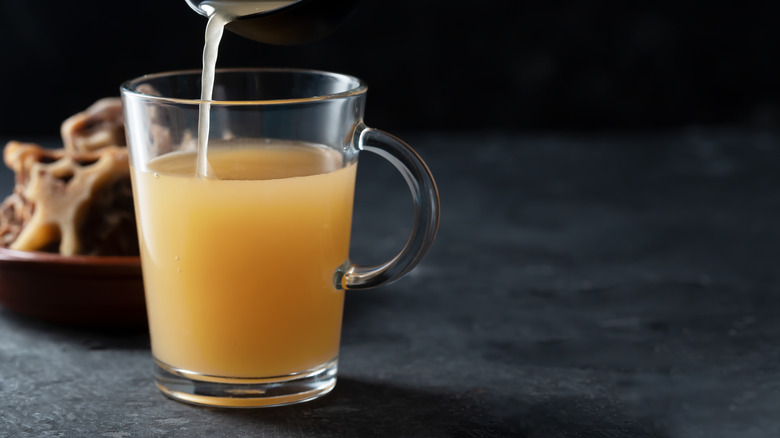14 Ways You're Messing Up Homemade Chicken Broth
A hot bowl of chicken soup is a welcome treat on a cold or rainy day. It helps warm you up from the inside out, and it can be especially enjoyable when you're feeling a bit sick. While you can always grab a few cans or boxes of chicken broth at the store and use them for your favorite soup recipes, if you've ever tasted homemade chicken broth, then you know that it is superior to anything you can purchase off the shelves.
However, if you don't make your homemade chicken broth the right way, it isn't going to turn out as wholesome and delicious. There are several mistakes you may be making when preparing chicken broth — or mistakes you'll want to avoid if you're looking to make chicken broth for the first time. Avoiding these mistakes will help ensure that each batch of chicken broth you make is ready to contribute the best flavor to the soups, casseroles, or other recipes you plan on using it for.
1. Not using organic chicken
The best chicken broth will come from the best chicken. For this reason, you should look to use organic chicken when preparing the broth. Organic chickens are fed an organic diet. The benefit of giving chickens organic feed is that they are not consuming any antibiotics, genetically-engineered ingredients, or animal by-products. Moreover, organic chickens must not be fed any items that are grown using chemical fertilizers or pesticides.
Choosing to use organic chicken means you'll be making sure that your broth is free of any of these potentially dangerous substances. Chemical pesticides and other toxins can be absorbed by the chicken and make their way into their bones. When you cook the bones down to make the broth, these toxins can then find their way into your broth and, later, into your body when you eat the meal you make with it. Starting with organic chicken means that you won't need to worry about the potential of adding toxins to the food you'll be enjoying and serving to others.
2. Not having all the ingredients you need
One big mistake that you don't want to make when preparing chicken broth is not having all the required ingredients. Leaving something out from the recipe will alter the taste of the broth, and it won't turn out as expected. You also won't want to stop in the middle of getting everything ready to have to run out to the grocery store to get what you're missing.
Different chicken broth recipes may vary slightly, but there are a few common ingredients between most recipes. These include chicken bones with meat on them, water, onions, carrots, celery, salt, pepper, a bay leaf, and seasonings like garlic, thyme, and rosemary. Before you plan on making chicken broth, consult the recipe you'll use and confirm that you have all the ingredients in your refrigerator or pantry. If not, leave yourself time to go to the store before you plan on making the broth. Also, be sure to double-check the quantity of each ingredient to ensure that you have what the recipe calls for as well as the ingredient's quality to ensure that you're cooking with the freshest possible additions.
3. Not adding the right ratio of ingredients
In addition to making sure you're ready with all the ingredients you'll need, it is also essential to make sure that you add the right ratio of ingredients to the pot when preparing your chicken broth. First, you want to start with the correct quantities of chicken and water. In most cases, aim to use the equivalent of an entire chicken carcass (with some meat still on the bones) and between three and five quarts of water. This will yield plenty of broth and will also help ensure that it has the right amount of chicken flavor.
You will also want to use the correct amount of celery, onion, and carrots to impart some flavor to the broth without making it taste more like a true vegetable broth. About one carrot, one stalk of celery, and half an onion is typically sufficient for most chicken broth recipes. When determining which seasonings you should add and how much of each you should put in, think about how you plan on using the broth. Choose seasonings that will offer a nice complement to the recipe you plan on making. If you add salt to your chicken broth, don't add too much. Because the broth will be used as part of a different recipe, it could end up turning out too salty if the other ingredients also have a lot of salt in them.
4. Adding the chicken liver to the pot
If you've been adding chicken liver to your pot when making chicken broth, you might want to change that practice. Adding the chicken gizzard or heart to the broth is acceptable and shouldn't negatively impact its flavor. However, the same is not true for the liver. If you add liver to chicken broth or stock, it can give it a bitter taste. This bitter taste can have a negative impact on the overall taste of the broth and the other recipes you plan to use it for.
When preparing the ingredients for your broth, pull the liver aside from the chicken carcass and any other organs you intend to use. It is up to you whether you want to simply throw it away or compost it, or if you want to use it for another recipe, such as chicken liver pate or Louisiana dirty rice.
5. Not starting with cold water
Do you bring the water to a boil before adding your chicken bones, vegetables, and seasonings to the stock you're making? If so, you've identified another mistake you've been making that you will want to avoid the next time you make homemade chicken broth. While you eventually want the pot of ingredients to warm up and simmer together, it is best to start with cold water.
There are actually a few different reasons why starting with cold water is recommended when making chicken stock. First, if you start with cold water, it can help prevent the broth from getting cloudy as it cooks. You'll end up with a clear and more beautiful-looking broth. The other reason to start with cold water is that it will help retain more of the flavor proteins from the chicken and the vegetables. which will ensure that they are incorporated into the finished chicken broth. If you add the ingredients after the water is hot, the finished broth won't have quite the same flavor. The reason for this is that the hot water denatures the proteins in the chicken and vegetables. If this happens right away (when they are placed in hot water), the molecules holding the flavors of the chicken and veggies will be more difficult to extract.
6. Not cooking it for the right amount of time
Cooking time also matters when you're preparing chicken broth. You want to cook the ingredients together long enough for the chicken and vegetables to have a chance to impart their flavors to the mixture in the pot, but not too much beyond that. Most chicken broth recipes only call for simmering all the ingredients together for about two or three hours (or even less in some cases).
Compared to chicken stock and bone broth, chicken broth has the shortest cooking time. When you cook the ingredients for just a few hours, the result will be the clearer broth that you're looking for. Stocks and bone broths, on the other hand, have a darker color and a richer flavor. Chicken stock can cook for up to six hours, while bone broth should be cooked even longer (up to 48 hours). The much longer cooking time for bone broth allows the cartilage in the bones to break down and add more collagen to the mixture.
7. Not considering using a slow cooker
Another option to consider when making homemade bone broth is preparing it in a slow cooker instead of a stock pot on the burner. There are a few potential benefits to using a slow cooker, and evaluating these benefits can help you determine whether it is the right cooking vessel for your chicken broth. First, it is safer to leave a slow cooker unattended than it is to leave a pot on the stovetop unattended. This means that you will be able to let the chicken broth cook when you're at work, out with a friend, or even sleeping overnight.
Because the ingredients cook more slowly than they do on the stovetop, you can leave the water, bones, and veggies in the slow cooker for longer than they would need to cook on the stove. You should expect it to take about eight hours or so for your chicken broth to cook. Just make sure you set your slow cooker to low to avoid cooking everything too quickly. Also, keep in mind that you'll need a large enough slow cooker for this approach to work, so be sure to assess the size of the pot before adding the various ingredients to it.
8. Not using a large enough pot
Without the right pot, you won't be able to make homemade chicken broth. If you start with a pot that is too small, you're either going to end up with a mess of spilled ingredients all over your stove top, or you're not going to be able to add sufficient water to help the broth turn out correctly. Either way, you should not try making chicken broth without a pot that is large enough to hold all the ingredients.
Many standard stock pots are only eight quarts. While that may be just large enough for some instances, it is likely to be too small to hold an entire chicken carcass, three to five quarts of water, and all the other ingredients you need without feeling crammed. If you plan on making broths and stocks on a regular basis, invest in a good 20-quart stock pot. It will give you more than enough space to fit all of the ingredients you need and cook them together without worrying about anything boiling over the sides.
9. Not skimming the fat
If you've ever made chicken broth before, you know that a layer of whitish foam appears on the top of the pot as all the ingredients heat up together. This layer, which is sometimes referred to as scum, comes from the fatty meat on the chicken. It is technically OK to leave it alone and not skim it off of the top, but it generally isn't recommended. If the layer of foam isn't removed relatively promptly, the denatured collagen proteins that make it up will break down as the broth comes to a boil. These proteins will spread throughout the broth, giving it a cloudy appearance. You will not be able to remove the proteins after they have become spread throughout the broth, and thus, you'll be left with cloudy broth.
If you want your chicken broth to turn out clear, you'll need to skim the foamy fat away as soon as it appears on the surface of the pot. Start by bringing the broth to a low simmer — you don't want it going too quickly to avoid causing the foam to break down before you get a chance to remove it. Once simmering, use a skimming tool or a cool metal spoon to remove the foam and discard it.
10. Not straining the cooked broth
After you've added all the necessary ingredients and given everything a few hours to simmer on the stove, there is one more important step you cannot skip: the broth must be strained. You certainly do not want pieces of bone or cartilage to end up in your soup or any other recipe you plan on using the broth for.
A fine mesh strainer is ideal for separating the broth from all the bones, chicken bits, and vegetables, but if you don't have one you can use a colander lined with two or more cheesecloth layers. Place the strainer or cheesecloth-lined colander over another large pot or bowl, and slowly pour the broth through it. You may need to stop periodically to remove chunks of bones and vegetables to leave more space in the strainer. Keep in mind that a stock pot full of chicken broth and all its makings can be quite heavy. If you find that the full pot is too heavy to lift, you can start by using a pair of tongs to pull out some of the larger bones or chunks of meat. You could also ladle out the broth and fixings into the colander or strainer until the pot is light enough to lift and pour.
11. Not freezing it properly
While you can always make chicken broth right before you'll need it for a recipe, it can also be made ahead of time and stored for future use. Having some chicken broth in the freezer ready to go can be a big time saver on days when you otherwise wouldn't have time to make it. Before you stick part of all of the last batch of chicken broth you made into the freezer, it is important to understand how to properly freeze it.
There are two different approaches you can take. The first is to fill freezer-safe bags with about one cup of broth, and seal them to make sure that all of the air has been let out. These bags should then be laid flat on a tray and placed in the freezer for several hours. Once they are frozen solid, you will be able to stack them for easy access in the future. The other option is to fill an ice cube tray or muffin tin with chicken broth and freeze it. Once frozen, you can pop the chicken broth cubes out of the tray and place them in a freezer-safe bag. Think about how you are likely to use your leftover chicken broth, and how much you will need at a time, to help you decide which freezing option is best for you.
12. Not using it before it goes bad
The last thing you want is to spend your time and effort preparing homemade chicken broth only for it to go bad before you get a chance to use it. According to the USDA, refrigerated chicken broth is good for up to 4 days. After this time, its taste may be off, and it could potentially be unsafe to consume. Frozen chicken broth is good for about six months, but you should really aim to use it within three months. After this time, the broth will deteriorate more, which can have a negative impact on its flavor profile.
If you have some chicken broth in your fridge, and you're not sure whether it is still good, there are a few things you can do to see if it is OK to use. The first is to smell the broth. It should smell like chicken broth. If you notice any other odors, especially anything sour or unpleasant, it means that the broth has gone bad and should not be used.
You can also assess the color of the broth. If it looks different than it did when it was fresh and has more of a yellow or brown tone to it, it is probably better just to get rid of it. Also, take a look at the broth for any sign of mold or slime. If you notice either of these, definitely toss the broth and do not consume it or add it to a recipe. Finally, if the smell and appearance all check out, give the broth a quick taste. If anything doesn't taste right or it is sour, do not use it.
13. Not experimenting with different recipes to use it
There is nothing wrong with using your chicken broth for a favorite recipe, such as homemade chicken noodle soup. However, if you always make the same recipe, you're missing out on trying new things and seeing the difference that homemade chicken broth can make in a wide assortment of recipes.
In addition to chicken noodle soup, you can use chicken broth to make chicken and dumplings, chicken pho, chicken tortilla soup, wonton soup, or sausage and spinach tortellini soup. But it can also be used for so much more than soups with a clearer broth. For example, chicken broth is often included in recipes for cream of mushroom soup, zucchini soup, and tomato cauliflower soup. It also offers applications beyond soups, including making chicken pot pies, chicken Alfredo, several delicious casseroles, and even Cuban-style turkey. The next time you whip up a fresh batch of chicken broth, try a new recipe or two to see just how versatile it can be.
14. Not turning it into bone broth and drinking it
Instead of making chicken broth, consider making bone broth instead. Bone broth is rich in several key nutrients, such as collagen, protein, iron, magnesium, phosphorus, glutamine, calcium, and glucosamine. Drinking it can support joint health, promote healthier skin, help your body get better sleep, improve your immune system, and aid in the digestive process.
One key to making bone broth is using the right bones. You want to use chicken bones with lots of connective tissue as they will offer the best source of amino acids on collagen. Another important difference between making bone broth and chicken broth is that bone broth should be simmered for 16 hours or longer, while chicken broth will be complete after about two hours. The inclusion of more bones with connective tissue coupled with the longer cook times allows more collagen to be extracted from the bones and incorporated into the broth. This is why bone broth has more nutrients than standard chicken broth and about seven grams of protein compared to about one gram of protein in chicken broth.
